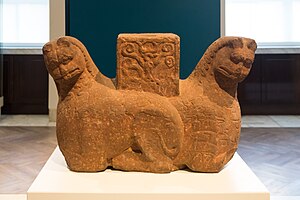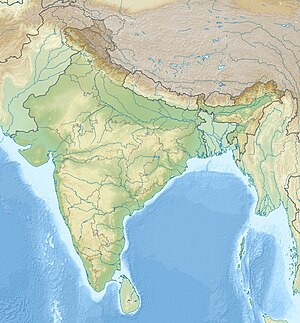| Mathura lion capital | |
|---|---|
 The Mathura lion capital on display in the Sir Joseph Hotung Gallery for China and South Asia, at the British Museum. | |
| Material | Red Sandstone |
| Size | Height 34cm Width 52.5cm |
| Writing | Prakrit inscription written in Kharoshthi script |
| Created | 1–10 CE |
| Discovered | Mathura in Central India |
| Present location | British Museum, London |
 Mathura (Discovery) | |
The Mathura lion capital is an Indo-Scythian sandstone capital (a part of a pillar) from Mathura in Northern India, dated to the first decade of the 1st century CE (1–10 CE).[1] It was consecrated under the rule of Rajuvula, one of the Northern Satraps of the region of Mathura.
The capital was unearthed at the Saptarishi mound of Mathura by Bhagwan Lal Indraji in 1869.[2] It is covered with Prakrit inscriptions in the kharoshthi script of northwestern India.[3] The capital was made on the occasion of the funeral of "the illustrious king Muki and his horse" (Muki has been conjectured to be Maues).
The capital describes, among other donations, the gift of a stupa with a relic of the Buddha, by Queen Ayasia, the "chief queen of the Indo-Scythian ruler of Mathura, satrap Rajuvula". The Mathura lion capital, an Indo-Scythian sandstone capital from Mathura in Central India, and dated to the 1st century CE, describes in kharoshthi the gift of a stupa with a relic of the Buddha, by queen Nadasi Kasa, "the wife of Rajuvula" and "daughter of Aiyasi Kamuia", who is mentioned as the "daughter of Kharahostes". The lion capital also mentions the genealogy of several Indo-Scythian satraps of Mathura. It mentions Sodasa, son of Rajuvula, who succeeded him and also made Mathura his capital.
The capital also displays at its center a Buddhist triratana symbol, further confirming the involvement of Indo-Scythian rulers with Buddhism.
The inscription indicates support of the Sarvastivadin, against the Mahasamghikas.[4]
It is on display in the South Asia section of the Sir Joseph Hotung Gallery for China and South Asia at the British Museum.
List of inscriptions
[edit]



In a Latin transliteration of simplified Kharosthi script, the inscriptions read:[6][7][8][9][10]
| Inscription | Original (Kharosthi script) | Transliteration | English translation |
|---|---|---|---|
| A1 | 𐨨𐨱𐨐𐨿𐨮𐨟𐨿𐨪𐨆𐨬𐨯 𐨪𐨗𐨂𐨫𐨯 | mahakṣatrovasa Rajulasa | Of the Great Satrap Rajuvula |
| A2 | 𐨀𐨒𐨿𐨪𐨨𐨱𐨅𐨮𐨁 𐨀𐨩𐨯𐨁𐨀 | agramaheṣi Ayasia | By the main Queen Ayasi |
| A3 | 𐨐𐨨𐨂𐨁𐨀 𐨢𐨁𐨟𐨿𐨪 | Kamuia dhitra | Kamuia, daughter |
| A4 | 𐨑𐨪𐨀𐨆𐨯𐨿𐨟𐨯 𐨩𐨂𐨬𐨪𐨙 | Kharaostasa yuvaraña | of the young king Kharahostes |
| A5 | 𐨨𐨟𐨿𐨪 𐨣𐨡𐨡𐨁𐨀𐨐𐨯 𐨩 | matra Nada-Diakasa ya | and mother of Nadadiaka, |
| A6 | 𐨯𐨢 𐨨𐨟𐨿𐨪 𐨀𐨦𐨂𐨱𐨆𐨫𐨀 | sadha matra Abuholaa | together with (her) mother, Abuhola, |
| A7 | 𐨤𐨁𐨟𐨿𐨪𐨨𐨱𐨁 𐨤𐨁𐨭𐨿𐨤𐨯𐨿𐨪𐨁𐨀 𐨧𐨿𐨪 | pitramahi Piśpasria bhra | (her) father's mother, Piśpasi, and (her) brother |
| A8 | 𐨟𐨿𐨪 𐨱𐨩𐨂𐨀𐨪𐨅𐨣 𐨯𐨢 𐨱𐨣𐨕𐨣 | tra Hayuarena sadha hanacana | Hayuara (and) together with the hanacana- |
| A9 | 𐨀𐨙𐨀𐨂𐨪𐨅𐨣 𐨱𐨆𐨪𐨐𐨤 | añaürena horakapa | añaüra donors' |
| A10 | 𐨪𐨁𐨬𐨪𐨅𐨣 𐨀𐨁𐨭 𐨤𐨿𐨪𐨢𐨬𐨁𐨤𐨿𐨪𐨟𐨅 | rivarena iśa pradhaviprate | retinue, in this place of the earth, |
| A11 | 𐨭𐨅 𐨣𐨁𐨯𐨁𐨨𐨅 𐨭𐨪𐨁𐨪 𐨤𐨿𐨪𐨟𐨅𐨛𐨬𐨁𐨟𐨆 | śe nisime śarira prateṭhavito | outside the monastery boundary, a relic is established |
| A12 | 𐨧𐨐𐨩𐨟𐨆 𐨭𐨐𐨨𐨂𐨞𐨁𐨯 𐨦𐨂𐨢𐨯 | bhakavato Śakamuṇisa Budhasa | of the Lord, the Śākya sage, Buddha, |
| A13 | 𐨭𐨐𐨁𐨨𐨂𐨪𐨩𐨯 𐨭𐨿𐨤𐨀𐨅 𐨧𐨂𐨯𐨬𐨁𐨱 | Śakimurayasa śpae Bhusaviha | king of the Śākya in his own Busa |
| A14 | 𐨪 𐨠𐨂𐨬 𐨕 𐨯𐨓𐨪𐨨 𐨯𐨓𐨪𐨨 𐨕 𐨕𐨟𐨂 | ra thuva ca sagharama ca catu | monastery, and also a stūpa, and quarters for the community, and the community of the four |
| A15 | 𐨡𐨁𐨭𐨯 𐨯𐨓𐨯 𐨯𐨪𐨿𐨬 | diśasa saghasa sarva | directions, the sangha of the |
| A16 | 𐨯𐨿𐨟𐨁𐨬𐨟𐨣 𐨤𐨪𐨁𐨒𐨿𐨪𐨱𐨅 | stivatana parigrahe | Sarvāstivādas possesses it. |
| B1 | 𐨨𐨱𐨐𐨿𐨮𐨟𐨿𐨪𐨬𐨯 | mahakṣatravasa | The Great Satrap |
| B2 | 𐨬𐨗𐨂𐨫𐨤𐨂𐨟𐨿𐨪𐨯 | vajulaputrasa | Rajuvula's son, |
| B3 | 𐨭𐨂𐨜𐨯 𐨐𐨿𐨮𐨟𐨿𐨪𐨬𐨅 | Śuḍasa kṣatrave | the Satrap Śuḍasa, |
| E4′′ | 𐨐 𐨐𐨪𐨁𐨟 | ka karita | makes |
| E1' | 𐨑𐨪𐨀𐨆𐨯𐨿𐨟𐨆 | Kharaosto | Kharahostes |
| E′ | 𐨐𐨨𐨂𐨁𐨀𐨆 𐨩𐨂𐨬𐨪𐨩 | Kamuio yuvaraya | Kamuia, the young king, |
| E2 | 𐨑𐨫𐨨𐨯 𐨐𐨂𐨨𐨪 | Khalamasa kumara | Prince Khalama, |
| E3 | 𐨨𐨗 𐨐𐨣𐨁𐨛 | Maja kaniṭha | and Maja the youngest, |
| E4 | 𐨯𐨨𐨣𐨂𐨨𐨆𐨡 | samanumoda | applaudants. |
| M1 | 𐨐𐨿𐨮𐨟𐨿𐨪𐨬𐨅 𐨭𐨂𐨜𐨁𐨯𐨅 | kṣatrave Śuḍise | The Satrap Śuḍasa |
| J2 | 𐨣𐨁𐨯𐨁𐨨𐨆 𐨐𐨪𐨁𐨟 𐨣𐨁𐨩𐨟𐨁𐨟𐨆 | nisimo karita niyatito | outside the monastic boundary; he offers |
| M2 | 𐨀𐨁𐨨𐨆 𐨤𐨢𐨬𐨁 | imo padhavi | of the earth |
| M3 | 𐨤𐨿𐨪𐨟𐨅𐨭𐨆 | prateśo | this region, |
| I2 | 𐨣𐨨𐨆 𐨐𐨢 | namo kadha | called |
| I3 | 𐨬𐨪𐨆 | varo | the encampment |
| I1a | 𐨬𐨅𐨩𐨀𐨡𐨁𐨪𐨿𐨞 | Veyaadirṇa | Veyaadirṇa |
| I4 | 𐨬𐨁𐨩𐨀 | Viyaa | (and) the Viyaa |
| I1b | 𐨐𐨢𐨬𐨪𐨐𐨆 𐨦𐨂𐨯𐨤 | kadhavare Busapa | encampment, from the Busa |
| J1 | 𐨪𐨿𐨬𐨟𐨐𐨅𐨣 𐨤𐨫𐨁𐨖𐨁𐨣 | rvatakena palichina | Mountain separated. |
| KL3 | 𐨀𐨂𐨟𐨀𐨅𐨣 𐨀𐨩𐨨𐨁𐨟 | utaena ayamita | It is accepted by the water |
| KL1 | 𐨀𐨩𐨪𐨁𐨀𐨯 | ayariasa | by the teacher |
| KL2 | 𐨦𐨂𐨢𐨟𐨅𐨬𐨯 | Budhatevasa | Budhateva. |
| F1 | 𐨦𐨂𐨢𐨁𐨫𐨯 𐨣𐨐𐨪𐨀𐨯 | Budhilasa nakaraasa | By Budhila, a city-dweller |
| F2 | 𐨧𐨁𐨑𐨯 𐨯𐨪𐨿𐨩𐨅𐨯𐨿𐨟𐨁𐨬𐨟𐨯 | bhikhasa Sarvestivatasa | (and) Sarvāstivāda monk, |
| G1 | 𐨨𐨱𐨐𐨿𐨮𐨟𐨿𐨪𐨬𐨯 𐨐𐨂𐨯𐨂𐨫𐨀𐨯 𐨤𐨟𐨁𐨐𐨯 𐨨𐨅𐨬𐨐𐨁𐨯 | mahakṣatravasa Kusulaasa Patikasa Mevakisa | in honour of the Great Satrap Patika Kusulaka, and of Mevaki |
| G2 | 𐨨𐨁𐨩𐨁𐨐𐨯 𐨐𐨿𐨮𐨟𐨿𐨪𐨬𐨯 𐨤𐨂𐨩𐨀𐨅 | Miyikasa kṣatravasa puyae | Miyika, the satrap, |
| J3 | 𐨯𐨪𐨿𐨬𐨯𐨿𐨟𐨁𐨬𐨟𐨣 𐨤𐨪𐨁𐨒𐨿𐨪𐨱 | Sarvastivatana parigraha | in the possession of the Sarvāstivādas. |
| N1 | 𐨀𐨩𐨪𐨁𐨀𐨯 𐨦𐨂𐨢𐨁𐨫𐨯 𐨣𐨐𐨪𐨐𐨯 𐨧𐨁𐨑𐨂 | ayariasa Budhilasa nakarakasa bhikhu | The teacher Budhila, city-dweller and monk |
| N2 | 𐨯 𐨯𐨪𐨿𐨬𐨯𐨿𐨟𐨁𐨬𐨟𐨯 𐨤𐨪𐨁𐨒𐨿𐨪 | sa Sarvastivatasa parigra | of the Sarvāstivāda community, his act of possession |
| N3 | 𐨣 𐨨𐨱𐨯𐨓𐨁𐨀𐨣 𐨤𐨿𐨪 | na Mahasaghiana pra | to the Mahāsāṃghikas |
| N4a | 𐨙𐨬𐨁𐨟𐨬𐨅 | ñavitave | must be announced. |
| P1 | 𐨯𐨪𐨿𐨬𐨯 𐨯𐨐𐨯𐨿𐨟 | sarvasa Sakasta | In the whole of |
| P2 | 𐨣𐨯 𐨤𐨂𐨩𐨀𐨅 | nasa puyae | Sakastan's honour, |
| O1 | 𐨯𐨪𐨿𐨬𐨦𐨂𐨢𐨣 𐨤𐨂𐨩 𐨢𐨨𐨯 | sarvabudhana puya dhamasa | may all the Buddhas be honoured, may the Dharma |
| O2 | 𐨤𐨂𐨩 𐨯𐨓𐨯 𐨤𐨂𐨩 | puya saghasa puya | be honoured, may the Sangha be honoured. |
| R1 | 𐨟𐨐𐨿𐨮𐨁𐨫𐨯 | Takṣilasa | Of Taxila. |
| R2 | 𐨐𐨿𐨪𐨆𐨣𐨁𐨣𐨯 | Kroninasa | Of Kronina. |
| N4b | 𐨑𐨫𐨆𐨫𐨯 | Khalolasa | Of Khalola. |
| Q1 | 𐨑𐨪𐨿𐨡𐨀𐨯 | Khardaasa | Khardaa, |
| Q2 | 𐨐𐨿𐨮𐨟𐨿𐨪𐨬𐨯 | kṣatravasa | the Satrap. |
| J′1 | 𐨑𐨫𐨭𐨨𐨂 | Khalaśamu | Khalaśamuśa |
| J′2 | 𐨭𐨆 | śo | |
| C1 | 𐨐𐨫𐨂𐨁𐨀 | Kaluia | Kaluia, |
| C2 | 𐨬𐨪𐨗𐨆 | Varajo | Varaja, |
| C3 | 𐨐𐨨𐨂𐨐 | Kamuka | Kamuka, |
| D | 𐨣𐨀𐨂𐨫𐨂𐨡𐨆 | Nauludo | Naaluda. |
| H′ | 𐨢𐨨𐨡𐨣 | dhamadana | Dharma gift, |
| H | 𐨒𐨂𐨬𐨁𐨱𐨪 | guhavihara | in the cave monastery. |
Interpretation
[edit]
Sten Konow, who compiled a definitive listing of Indian Buddhist inscriptions said: "If we bear in mind that mb becomes m i.e mm in the dialect of Kharoshthi dhammapada, and that is used for the common o in Sudasa in the Lion Capital Inscriptions, the Kamuia of the Lion Capital can very well represent a Sanskrit Kambojika ... I shall only add that if Kharoshtha and his father Arta were Kambojas, the same may have been the case with Moga, and we understand why the Kambojas are sometimes mentioned with the Sakas and Yavanas".[11] Many of Konow's readings, his sequence of sentences and some of the interpretation, particularly the connection with king Maues, need to be changed in the light of a new reading of H. Falk.[12]
References
[edit]- ^ Salomon, Richard (July 1996). "An Inscribed Silver Buddhist Reliquary of the Time of King Kharaosta and Prince Indravarman". Journal of the American Oriental Society. 116 (3): 442. doi:10.2307/605147. JSTOR 605147.
- ^ Jason Neelis (19 November 2010). Early Buddhist Transmission and Trade Networks: Mobility and Exchange Within and Beyond the Northwestern Borderlands of South Asia. BRILL. p. 122. ISBN 978-90-04-18159-5.
- ^ "Red Sandstone Pillar Capital". British Museum. Archived from the original on 16 December 2010. Retrieved 1 August 2010.
- ^ Rosenfield, John M. (1967). The dynastic art of the Kushans. University of California Press. p. 134.
- ^ Konow, Sten (1929). Kharoshthi Inscriptions With The Exception Of Those Of Asoka. India. p. 35.
{{cite book}}: CS1 maint: location missing publisher (link) - ^ "List of the inscriptions on the Mathura lion capital".
- ^ Jongeward, David; Errington, Elizabeth; Salomon, Richard; Baums, Stefan (2012). "Catalog and Revised Text and Translations of Gandhāran Reliquary" (PDF). Gandhāran Buddhist Reliquaries. Seattle: Early Buddhist Manuscripts Project. p. 219-222. ISBN 978-0-295-99236-5.
- ^ Albery, Henry (2020). Buddhism and Society in the Indic North and Northwest: 2nd Century BCE – 3rd Century CE (PDF). Munich: Ludwig-Maximilians-Universität München. pp. 352–361.
- ^ Harmatta, János (1999). "Languages and scripts in Graeco-Bactria and the Saka Kingdoms". In Harmatta, János; Puri, B. N.; Etemadi, G. F. (eds.). History of civilizations of Central Asia. Vol. 2. Delhi: Motilal Banarsidass Publishing House. p. 409-416. ISBN 978-8-120-81408-0.
- ^ Thomas, F. W. (1907–1908). Hultzsch, E.; Konow, Sten (eds.). Epigraphia Indica. Vol. 9. Kolkata: Office of the Superintendent of Government Printing, India. pp. 135–147.
- ^ Sten Konow, Corpus Inscriptionum Indicarum, Vol II, Part I, p. xxxvi, p. 36
- ^ Harry Falk, "Ten thoughts on the Mathura Lion capital reliquary". Bhandare, Shailendra & Sanjay Garg (eds.), "Felicitas – Essays in Numismatics, Epigraphy and History in Honour of Joe Cribb". Mumbai, pp. 121–141
Sources
[edit]- Baums, Stefan. 2012. "Catalog and Revised Texts and Translations of Gandharan Reliquary Inscriptions." In: David Jongeward, Elizabeth Errington, Richard Salomon and Stefan Baums, Gandharan Buddhist Reliquaries, pp. 219–222, Seattle: Early Buddhist Manuscripts Project (Gandharan Studies, Volume 1).
- Baums, Stefan, and Andrew Glass. 2002– . Catalog of Gāndhārī Texts, no. CKI 48
- British Museum Collection Online Reg. No. 1889,0314.1 [1]